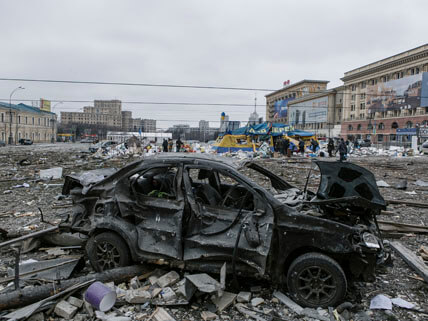
A view of the central square following shelling of the City Hall building in Kharkiv, Ukraine, Tuesday, March 1, 2022.
On February 24, Russian forces invaded Ukraine, one of the countries along Russia’s western border. The invasion began after Russian President Vladimir Putin announced “a special military operation” in a pre-dawn address. Russian attacks were launched at the north, east, and south of Ukraine, targeting airports, military installations, and major cities. Ukrainian President Volodymyr Zelenskyy responded by immediately severing diplomatic relations with Russia and mobilizing the military for war. Many civilians have joined efforts to mount a fierce resistance despite considerable disadvantages in troops and weapons. Posts on social media have shown Ukrainians from all walks of life taking up arms to defend their country.
Approximately one week into the invasion, aerial attacks intensified on Ukraine’s second-largest city, Kharkiv. At least 21 people have been killed and over 100 injured in the city, which has a total population of about 1.5 million. Elsewhere, a line of Russian tanks and military vehicles about 40 miles long has advanced slowly on Ukraine’s largest city and capital, Kyiv, and the city has suffered several air attacks. Russian missiles struck a hospital in the northern city of Chernihiv, and Russian forces launched attacks on the southern port cities of Kherson and Mariupol. It is now believed that Kherson has become the first major Ukrainian city to fall under Russian control.
Russian President Putin has attempted to justify the invasion by claiming Russia’s safety and development is threatened by Ukraine’s attempts to join the European Union and the North Atlantic Treaty Organization (NATO) military alliance. Putin has also leveled unfounded claims of genocide and Nazism in Ukraine as a pretext for war. Zelenskyy, Ukraine’s first Jewish president, has rejected Putin’s comments and has said of the invasion, “This is the sound of a new Iron Curtain, which has come down and is closing Russia off from the civilised world.”
The conflict has led to a great humanitarian crisis as the number of people fleeing Ukraine has surpassed one million. Some estimates project that as many as four million people may eventually flee the country. There is also great concern that the 15 nuclear reactors in Ukraine could be damaged in the fighting, triggering a nuclear disaster. Russian and Ukrainian delegations are scheduled to meet March 3 in Belarus for talks to negotiate a diplomatic end to the conflict.
The global response to the invasion has been overwhelmingly supportive of Ukraine. On March 2, the United Nations General Assembly voted on a resolution demanding that Russia stop fighting and withdraw from Ukraine. Of the assembly’s 193 member states, 141 voted to support the resolution. Many countries including the United States have imposed harsh economic sanctions against Russia, and many have also closed their airspace to Russian aircraft. The European Union is planning to buy and deliver weapons to Ukraine, marking the first time that the union has bought and supplied weapons to a country under attack.
Russia and Ukraine have an intertwined and tumultuous history spanning centuries. During the twentieth century in 1922, Ukraine was one of the founding republics of the Soviet Union along with Armenia, Azerbaijan, Belarus, Georgia, and Russia. In August 1991, Ukraine officially declared independence just months before the collapse of the Soviet Union in December. In the decades that followed, different administrations in Ukraine either closely aligned with Russia or sought greater autonomy.
In early 2014, Ukrainian president Viktor Yanukovuch resigned and fled to Russia after months of massive protests across Ukraine. Many Ukrainians felt Yanukovuch’s government was corrupt and were angered by his refusal to sign a free trade agreement with the European Union. In response, Russia declared the change in Ukraine’s government illegal and took control of the mostly pro-Russian Crimean Peninsula in Ukraine’s south. Russia also increased support of separatist movements in the regions of Donetsk and Luhansk in Ukraine’s southeast, fueling an armed conflict that continues to this day. In late 2021, Russian President Putin amassed tens of thousands of troops along the Russian border with Ukraine, which are now carrying out the invasion.
Image credit: ©Pavel Dorogoy/AP Images
Sources
- Refugee count tops 1 million; Russians besiege Ukraine ports
(Source: AP News; accessed March 3, 2022) - Russia-Ukraine War: What to know on Day 7 of Russian assault
(Source: AP News; accessed March 1, 2022) - Ukraine now says 90,000 Russian troops not far from border
(Source: AP News; accessed March 1, 2022) - Ukraine maps: Russians take Kherson but Kyiv advance slows
(Source: BBC News; accessed March 3, 2022) - Why is Russia invading Ukraine and what does Putin want?
(Source: BBC News; accessed March 1, 2022) - Ukraine severed diplomatic relations with Russia
(Source: Interfax; accessed March 1, 2022) - Russia’s at war with Ukraine. Here’s how we got here
(Source: NPR; accessed March 1, 2022) - Missiles rain down around Ukraine
(Source: Reuters; accessed March 1, 2022) - Putin’s invasion of Ukraine, explained
(Source: Vox; accessed March 1, 2022) - The Russia-Ukraine War: Latest News and Live Updates
(Source: The Wall Street Journal; accessed March 2, 2022) - How Ukrainians have used social media to humiliate the Russians and rally the world
(Source: The Washington Post; accessed March 3, 2022)



